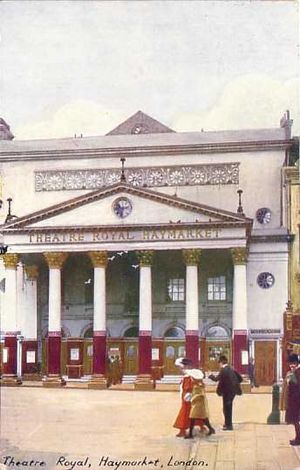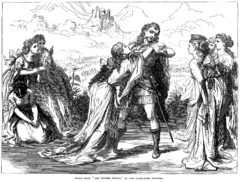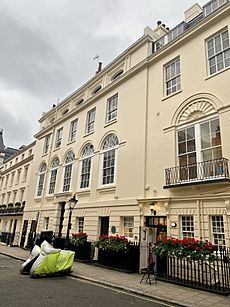Theatre Royal Haymarket facts for kids
|
1720: Little Theatre (nearby)
1767: Theatre Royal |
|
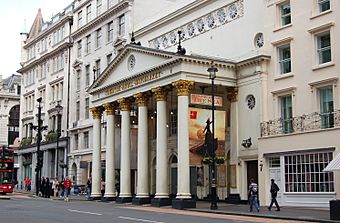
The theatre in 2008, showing Edward Bond's The Sea
|
|
| Address | Suffolk Street, Haymarket London, SW1 United Kingdom |
|---|---|
| Coordinates | 51°30′31″N 0°7′53″W / 51.50861°N 0.13139°W |
| Public transit | |
| Owner | Access Entertainment |
| Operator | Access Entertainment |
| Type | West End theatre |
| Capacity | 888 on 4 levels |
| Production | Till the Stars Come Down |
| Construction | |
| Opened | 4 July 1821 (current structure) |
| Rebuilt | 1879: proscenium and removal of pit 1904: auditorium 1994: major refurbishment |
| Years active | 1720–present |
| Architect | John Nash |
| Website | |
| www.trh.co.uk | |
|
Listed Building – Grade I
|
|
| Official name: The Haymarket Theatre (Theatre Royal) | |
| Designated: | 14 January 1970 |
| Reference #: | 1066641 |
The Theatre Royal Haymarket, also known as the Haymarket Theatre, is a famous theatre in Haymarket, London. It first opened in 1720, making it one of the oldest theatres still in use in London. In 1766, it received a special "royal patent" which allowed it to perform serious plays.
The theatre moved to its current spot in 1821. The famous architect John Nash designed the building you see today. It is a Grade I listed building, which means it's a very important historical building. The theatre can seat 888 people.
The Haymarket Theatre has been a place of many new ideas in theatre. For example, in 1873, it held the first ever scheduled afternoon show, called a matinée. This idea soon became popular in theatres everywhere. Many famous actors have performed here, and some even started their careers on its stage.
Contents
History of the Theatre
How the Theatre Began
The first Haymarket Theatre was built in 1720 by a carpenter named John Potter. It was located on the site of an old inn. This was the third public theatre to open in London's West End. It cost about £1000 to build, with more money spent on decorations and costumes.
The theatre opened on December 29, 1720, with a French play. At first, it was called The New French Theatre, but later it became known as the Little Theatre in the Hay.
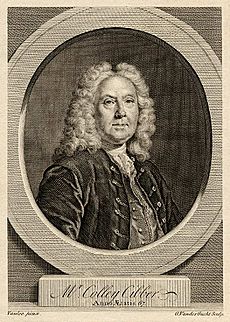
A big success for the theatre was a play called Hurlothrumbo, or The Supernatural in 1729. It ran for 30 nights, which was a long time back then! In 1730, an English acting group took over the theatre.
The theatre was known for showing plays that made fun of important people, like the prime minister, Robert Walpole. This led to a new law in 1737, called the Licensing Act 1737. This law made it much harder for theatres to put on plays without special permission. It almost closed the Haymarket Theatre completely.
For a while, people found clever ways to put on shows. They would advertise a "concert" and then, for free, put on a "rehearsal" that was actually a play.
In 1749, a strange event happened. A trickster claimed he could put his body inside an empty wine bottle on stage! Of course, he didn't show up, and the audience got so angry they damaged the theatre.
Becoming a Royal Theatre
In 1758, Samuel Foote worked to make the Haymarket a regular theatre. With help from the Duke of York, he got a special "royal licence" to perform plays for four months each year. He also bought the theatre and made it bigger.
On May 14, 1767, it reopened as the Theatre Royal. This made it one of only three "patent theatres" in London, meaning it had royal permission to stage plays. Foote put on many successful plays here.
However, Foote often made fun of well-known people in his plays. This, along with his health problems, led him to sell the theatre in 1777 to George Colman Sr..
During 1793–94, while another theatre was being rebuilt, the Haymarket was used more often. A sad event happened on February 3, 1794. Many people rushed to see the King, who was at a performance, and 20 people lost their lives in the crowd.
In 1820, the area around the theatre was rebuilt by John Nash. Nash convinced the theatre owners to move the building slightly south. This way, the theatre's grand entrance would be a beautiful view from a nearby street. Nash added the large portico with six columns that you see today. The theatre reopened on July 4, 1821.
Famous Plays and People (1800s)
From 1837 to 1853, Benjamin Nottingham Webster managed the theatre. He and the next manager, John Baldwin Buckstone, made the Haymarket famous for comedies. Many great actors of the time performed there.
In 1862, the play Our American Cousin ran for 400 nights! This play was so popular it even added the word "dreary" to common language. W. S. Gilbert, a famous playwright, had seven of his plays first performed at the Haymarket. These included his "fairy comedies" like The Palace of Truth (1870) and Pygmalion and Galatea (1871).
Some people say that Buckstone's ghost is often seen at the theatre, especially during comedies. In 2009, actor Patrick Stewart even reported seeing the ghost during a play!
In 1879, the theatre was taken over by the Bancrofts. They made big changes to the inside, including adding a "picture frame proscenium" around the stage, which was a first for London. They also changed the seating, which made some audience members angry on opening night!
Herbert Beerbohm Tree became manager in 1885. He brought electric lights to the theatre. Under his management, Oscar Wilde's comedies A Woman of No Importance (1893) and An Ideal Husband (1895) first played here. Tree's success allowed him to build another famous theatre, Her Majesty's Theatre.
In 1896, Cyril Maude and Frederick Harrison took over. J. M. Barrie's The Little Minister ran for 320 performances in 1897.
The 20th Century at Haymarket
Early 1900s Productions
Frederick Harrison continued to manage the Haymarket in the early 1900s. In 1904, the inside of the theatre was redesigned in a fancy French style.
Many popular plays were shown before and during World War I. These included Bunty Pulls the Strings (1911), which ran for 617 performances, and General Post (1917), which ran for 532 performances.

In 1920, J. M. Barrie's Mary Rose had a long run of 399 performances. Another play, Yellow Sands, ran for 610 performances in 1926–27.
During World War II, the theatre continued to put on shows. These included Noël Coward's Design for Living (1939) and a special season of plays by John Gielgud in 1944–1945. Gielgud directed The Beggar's Opera in 1940.
Later in the 1940s, plays like Oscar Wilde's Lady Windermere's Fan (1945) and Tennessee Williams's The Glass Menagerie (1948) were performed.
Mid-20th Century Shows
In the 1950s, Waters of the Moon (1951–52) starred famous actresses Sybil Thorndike and Edith Evans. For the Coronation in 1953, Noël Coward himself performed in a play by George Bernard Shaw. Coward called the Haymarket "the most perfect theatre in the world."
The theatre continued to host many well-known actors and plays. These included Flowering Cherry (1957) with Ralph Richardson and Celia Johnson, and Ross (1960) with Alec Guinness. John Gielgud also directed The School for Scandal in 1962.
Late 20th Century Performances
In the 1970s, popular shows included A Voyage Round My Father (1971–72) starring Alec Guinness, and Crown Matrimonial (1972) with Wendy Hiller.
Later productions featured stars like Geraldine McEwan, Edward Woodward, Ingrid Bergman (in her last stage role), and Penelope Keith.
The 1980s brought plays like Make and Break (1980) with Leonard Rossiter and Prunella Scales. The theatre also had a season of different plays, including Hobson's Choice with Penelope Keith and Man and Superman with Peter O'Toole.
Other famous actors who performed in the 1980s included Rex Harrison, Ben Kingsley, Christopher Reeve, Vanessa Redgrave, Lauren Bacall, Maggie Smith, Timothy Dalton, Derek Jacobi, and Jack Lemmon.
In 1994, the theatre closed for a big renovation that cost £1.3 million. It reopened later that year with An Evening with Peter Ustinov. Other plays included Tom Stoppard's Arcadia and Oscar Wilde's An Ideal Husband, which returned 100 years after its first performance at the Haymarket.
In 1996, Neil Simon's The Odd Couple starred Tony Randall and Jack Klugman. Later, Jessica Lange starred in A Streetcar Named Desire (1997).
The 21st Century at Haymarket
In the 2000s, the Haymarket continued to host major stars. Judi Dench starred in The Royal Family (2001) and later appeared with Maggie Smith in The Breath of Life (2002).
In 2004, a stage version of the movie When Harry Met Sally... was performed. During this show, parts of the ceiling fell, injuring some people, and the theatre closed for two nights for repairs.
In 2005, Victoria Wood's musical Acorn Antiques: The Musical was a hit, starring Julie Walters. In 2006, there were revivals of A Man for All Seasons with Martin Shaw and Noël Coward's Hay Fever with Judi Dench.
In 2009, famous actors Ian McKellen and Patrick Stewart starred in Waiting for Godot. This play, along with Breakfast at Tiffany's, was featured in a TV documentary series called Theatreland. Waiting for Godot returned in 2010.
Trevor Nunn became the Artistic Director in 2011. He brought plays like Flare Path with Sienna Miller and The Tempest with Ralph Fiennes. From 2012 to 2014, the theatre hosted the popular comedy One Man, Two Guvnors.
Recent productions have included a stage version of the film Fatal Attraction (2014), and The Elephant Man (2015) starring Bradley Cooper. In 2016, Pixie Lott made her theatre debut in Breakfast at Tiffany's.
In 2019, the theatre was sold to Access Entertainment. In February 2019, Only Fools and Horses The Musical opened. It became the longest-running show in the Haymarket's history, playing over 1,000 times before closing in April 2023.
Since then, the theatre has hosted Accidental Death of an Anarchist (2023), Noises Off (2023), The Picture of Dorian Gray (2024) starring Sarah Snook, A View from the Bridge (2024) starring Dominic West, and another run of Waiting for Godot (2024).
In 2025, the theatre has hosted Bill Bailey - Thoughtifier and The Score starring Brian Cox.
Masterclass
In 1998, the Haymarket Theatre started a charity called Masterclass. This program helps young people aged 17 to 30 who want to work in performing arts.
Masterclass offers many opportunities, like special classes with leading actors and directors. Young people can learn about acting, directing, writing, and even theatre design. Over 60,000 young people have taken part in these classes.


